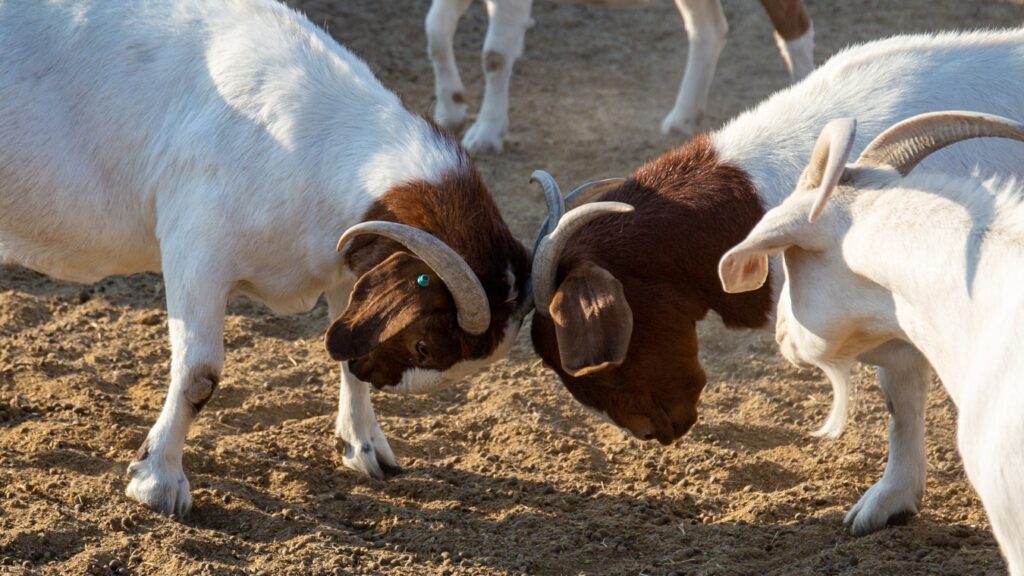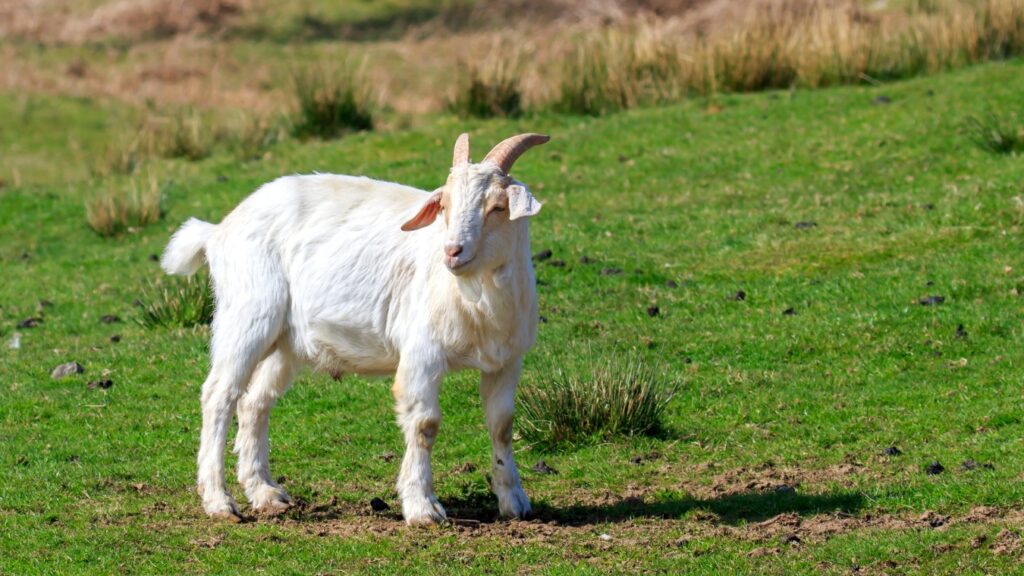Uncover the differences between Savanna goats and Boer goats to make the best choice for your farm. Learn about Savanna Goats Vs Boer Goats now!
Table of Contents
Introduction
Choosing the right goat breed for your farm can be a tough decision. Savanna goats, with their strong legs and muscular build, offer farmers a robust option. This article delves into the differences and similarities between Savanna goats and Boer goats to help you make an informed choice.
Discover which goat will best suit your farming needs!
Key Takeaways
- Savanna and Boer goats come from South Africa, with white coats and good meat. They are tough and can live in rough places.
- Savanna goats have shorter legs and strong bones. They are good mothers to their kids. Boer goats grow fast for quality meat.
- Both types of goats breed well, often having twins or triplets. Their babies grow up healthy on farms.
- You need to give Savanna goats grasses, shrubs, and hay to eat. This helps them stay fit for farming.
- While raising Savanna goats has many benefits like toughness and good mothering, they also face problems like health issues in their legs if not cared for right.

What is a Savanna Goat?
Savanna goats are a breed of meat goats that originate from South Africa. They are known for their compact build, short legs, and adaptability to harsh environments. With their white coat and strong mothering abilities, Savanna goats have become popular in the meat production industry.
Physical characteristics
Savanna goats stand out with their white color and muscular build. They have good bones, strong legs, and durable hooves built for tough environments. These meat goats are compact with shorter legs compared to other breeds.
Their body is designed for efficiency in grazing and roaming the veld.
Their faces often show a black or brown coloration around the eyes that lends them a distinctive look. Known for being lively animals, they run, jump, and easily climb terrain. They do display robust mothering ability ensuring their young grow healthy and protected.
This breed’s physical traits contribute to its reputation as hardy livestock capable of thriving in various conditions.
Uses and history
Farmers value Savanna goats for their meat. These white South African goats pack on muscle and have dense bones, making them ideal for high-quality meat production. They adapt well to rough environments, a trait inherited from their roots in the unforgiving African veld.
The history of Savanna goats is full of survival and thrive. Bred in Africa, these purebred goats are known for fertility and mothering abilities, earning respect worldwide. Now consider how these traits affect reproduction and breeding practices among goat farmers.
Comparison: Savanna Goats Vs Boer Goats
Savanna goats and Boer goats are two popular meat goat breeds with some similarities but also distinct differences in appearance, temperament, and use. While both are known for their fertility and adaptation to harsh environments, they differ in physical build and mothering ability.
Read on to learn more about these two unique goat breeds.
Similarities
Both Savanna goats and Boer goats hail from South Africa and share several traits. They are both known for their robustness, adaptability to tough environments, and excellent meat production qualities.
These two goat breeds have strong mothering skills and bond well with their offspring. Their white coat is another common feature, making them easily recognizable.
Savannas and Boers excel in fertility rates, which makes them valuable assets in livestock farming. Farmers choose these breeds when they need animals that can thrive in harsh conditions while still producing high-quality meat.
They are top picks for raising healthy herds capable of grazing effectively on pastureland.
Differences in appearance, temperament, and use
Savanna goats have a white color and a compact build with shorter legs, while Boer goats are typically brown with a distinctive red head. Savanna goats display docile and amenable temperament but can be lively, enjoying running, jumping, and climbing.
In contrast, Boer goats are known for their calm nature and adapt well to being handled by humans. Savanna goats are better suited for harsh environments due to their hardy nature and strong hooves compared to the fast growth rate of Boer goats suitable for high-quality meat production.
When considering appearance, temperament, and use, it’s essential to understand how these differences affect the selection of goat breeds for specific farming needs.

Reproduction and Breeding
Savanna goats have a high fertility rate and are excellent mothers, often giving birth to twins or triplets. They reach sexual maturity at around 4-6 months, making them ideal for breeding purposes.
Breeding techniques such as crossbreeding with Boer goats can result in superior meat production and adaptability to different environments.
Pregnancy and Birth
Savanna goats have a high fertility rate, often giving birth to multiple kids. Pregnancy in these goats lasts for about five months before they are delivered. They are known for their exceptional mothering ability and bond strongly with their young ones from birth.
They typically give birth without much intervention due to their strong instincts and adaptability to harsh environments.
Boer goats also exhibit high fertility rates and are known for easy kidding and good maternal instincts. Pregnancy in Boer goats lasts around 150 days, after which they give birth to vigorous kids that quickly adapt to grazing on pasture lands.
Weaning and sexual maturity
Savanna goats typically wean their kids at about 3 months old. They reach sexual maturity by the age of 5 to 6 months, depending on the individual goat’s development. It is essential to monitor and separate young bucks and does as they approach sexual maturity to prevent unwanted breeding.
Proper nutrition during this period is crucial for healthy growth and development, ensuring that the goats reach their full potential.
Breeding techniques
- Savanna goats are bred using selective mating to maintain their desirable characteristics, such as good mothering ability and adaptability to harsh environments.
- Controlled mating is essential to ensure genetic diversity and prevent inbreeding, which can compromise the hardiness of the offspring.
- The breeding process involves carefully monitoring the does for signs of heat, indicating they are ready for mating.
- Proper nutrition is crucial during breeding to optimize reproductive health and ensure successful pregnancies.
- To maintain high fertility rates, Savanna goat breeders often implement strategic breeding seasons aligned with optimal environmental conditions.
- Breeders also utilize artificial insemination techniques to introduce genetic traits from superior male goats into their herds.
- It’s important for breeders to regularly assess the health and well-being of both the does and bucks involved in the breeding program.
Habitat and Diet
Savanna goats are well-adapted to harsh environments, making them suitable for grazing in rangelands with limited resources. Their ideal diet consists of a mixture of grasses, shrubs, and other vegetation found in their natural habitat.
Adaptation to environment
Savanna goats have impressive adaptation skills to harsh environments, making them suitable for various climates. Their hardiness allows them to thrive in rugged terrains and arid conditions, showcasing their resilience to challenging environments.
These goats excel in grazing on sparse vegetation and can withstand temperature fluctuations, proving their ability to adapt well to different surroundings.
Their compact build and strong legs enable Savanna goats to navigate diverse landscapes with ease while foraging for food. Additionally, their white coat helps regulate body temperature under intense sun exposure, further demonstrating their adaptation capabilities.
Ideal diet for Savanna goats
Savanna goats, being hardy and adaptable, have specific dietary needs that contribute to their optimal health and development. These goats thrive on a diet primarily consisting of grasses, forbs, and shrubs found in their natural habitat.
They are efficient browsers and prefer a diverse range of plant species to meet their nutritional requirements. Additionally, providing them with good-quality hay and mineral supplements is essential for maintaining their overall well-being.
This balanced diet ensures the Savanna goats’ robustness and supports their ability to adapt to harsh environments while promoting better meat production.
Pros and Cons of Raising Savanna Goats
Savanna goats are known for their adaptability to harsh environments and their compact build, which makes them ideal for grazing. On the downside, they may have shorter legs compared to other goat breeds and require careful pasture management.
Advantages
Savanna goats have excellent reproduction and strong bone structure, making them well-suited for meat production. They are hardy and adaptable to harsh environments, thriving in grazing conditions that might be challenging for other breeds.
Additionally, their compact build and shorter legs make them agile and efficient climbers, making pasture management easier.
Their docile nature allows for easy handling and husbandry practices on the farm. With their good mothering ability, they ensure the wellness of their young ones. Moreover, Savanna goats’ adaptability to various climates makes them a valuable asset for livestock farming operations seeking resilience in changing environmental conditions as they offer not just meat but also adaptability under different circumstances.
Disadvantages
In contrast, raising Savanna goats also comes with some disadvantages. While they are known for their adaptability to harsh environments, their compact build and shorter legs can make them more prone to certain health issues such as foot rot and joint problems.
Additionally, despite their good mothering ability and high fertility rates, they may require more intensive care during kidding season compared to other goat breeds due to potential birthing complications.
Furthermore, because of the growing popularity of Boer goats in meat production, the market demand for Savanna goats may not be as high, affecting their profitability.
Conclusion
In conclusion, Savanna goats and Boer goats each have unique qualities. Both are hardy and adaptable to harsh environments, making them excellent choices for meat production. The compact build and mothering ability of Savanna goats make them stand out, while the fast growth rate and high-quality meat production of Boer goats are remarkable.
Whether you choose Savanna or Boer goats, they both offer valuable traits for successful goat farming.